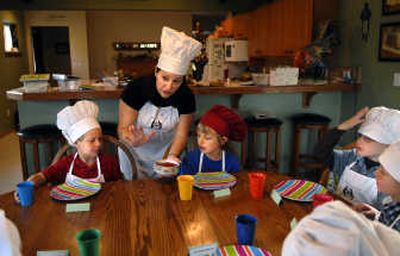It’s cooking club, boys and girls

The kitchen is Julie Sherwood’s home office. A longtime collector of cookbooks who likes to experiment with ingredients and create her own recipes, Sherwood didn’t expect to turn her love of cooking into a home-based business.
But three years ago, Sherwood looked for a “girly” activity outside of dance classes for her daughter, Madeline, who wasn’t into sports. Not finding what she was looking for, Sherwood stepped into the void by starting a cooking club called Sugar and Spice.
“Then word got out, and I got calls,” says Sherwood, who was surprised at how many boys and their parents were interested in her cooking class. Within a month she changed the name to the Jr. Chef Cooking Club and now has almost as many boys as girls enrolled and is in the process of franchising her class and curriculum.
Her kitchen and dining area, which is painted a soothing green and beige with the stenciled words, “A Glorious Feast,” is spacious enough to comfortably teach eight or more children at a time, including her own.
Recipe for a class
On a brisk autumn afternoon, five boys and three girls, ages 5 to 9, stand around the kitchen island in aprons and chef’s hats, ready to make pumpkin muffins. Most of the kids stand on overturned milk crates and towels, too short to mix ingredients without a boost.
Each week, one student gets to wear the red head chef hat, and this week is Brandon James’ turn. As head chef he stands beside Sherwood, reading the recipe and cracking eggs, if the recipe calls for them. Later the head chef gets to put out name placards and pass the completed recipe for sampling.
Participation is fun and fundamental to Sherwood’s class, with the children taking turns measuring and mixing, smelling and even tasting ingredients – only two liked the taste of raw pumpkin.
From the initial wash up to putting the muffins in the oven, Sherwood peppers her instruction with teaching questions like, “What if we wanted to make muffins healthier?” or “What happens if we don’t fill the recipe cup all the way?” The small chefs usually answer and then Sherwood clarifies, eventually covering everything from sanitation to a multitude of tricks and techniques that make a good recipe taste great.
“I love to see the kids faces when I ask a question and they know what it is and are thrilled out of their minds,” says Sherwood.
As soon as the muffins are in the oven, the students swarm to the dining table to scrapbook the recipe for their own personal cookbooks, small spiral binders that will have many complete menus of recipes come spring.
Just as they finish the art project, which features the pumpkin muffin recipe on an orange pumpkin with stem, vine tendrils and leaves, the muffins are ready to come out of the oven. As they cool on the rack, filling the kitchen and dining area with the mouth-watering scent of spice, the students wash the glue from their hands and quickly work together to set the table with brightly colored plates, cups and napkins.
Then they sample their muffins and Sherwood’s instruction continues, this time on proper table manners. At the end of the 90-minute class, the kids are almost done cleaning up when the parents arrive. They each take two muffins home to share, along with their cookbooks.
“Yes,” they say. “It does taste better when you make it yourself.”